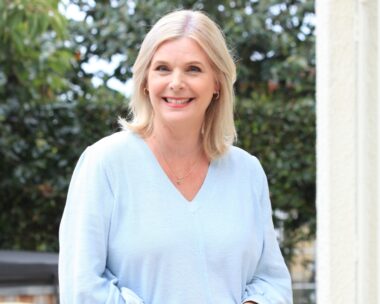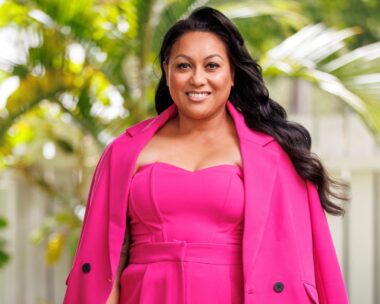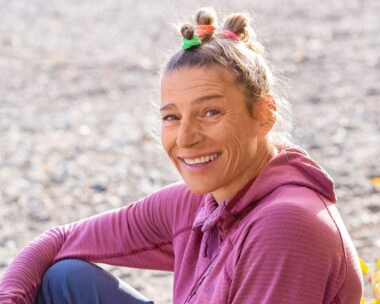On December 2 last year, her 59th birthday, Kim Dorsett asked to return to Dreamworld. She wanted to visit the Thunder Rapids ride, the place her children, Kate Goodchild and Luke Dorsett, had died, she said. She wanted to understand what had happened to them.
“Some people were surprised, but when the accident occurred, Kim was in such shock she didn’t really comprehend what had happened,” says Kim’s lifelong best friend Sandra Brookfield. “The staff met her and looked after her, and an Aboriginal blessing was held on the site. She got some comfort from that.”
Comfort has been hard to come by for Kim since Kate and Luke drowned on the ride, along with Luke’s partner, Roozbeh Araghi, and Cindy Low, in October 2016.
She asked Sandra not to send a gift at Christmas, preferring to spend the day by her children’s graves. She is sewing a patchwork quilt from Luke’s old clothes. She takes her baby granddaughter, Evie, for swimming lessons.
Sandra has been an almost daily confidante for her best mate. Kim telephones Sandra’s Penrith, NSW, home regularly and pours out her pain.
“We reminisce and reminisce,” Sandra says.

Mostly, they talk about Kate and Luke.
Kim, says Sandra, desperately clings onto the last happy memory she has of her family together, sharing a lamb roast the evening before she waved them off to Dreamworld. Kim was alone in their holiday apartment when she got the phone call about the deaths of her children.
Sandra knows that Kim’s trauma will not fade any time soon, as she faces years of legalities ahead. She knows, too, it hasn’t faded for many other visitors to Australia’s famous theme parks.
“I hear so many parents arguing about whether our theme parks are safe,” Sandra says.
“If I had grandchildren, I wouldn’t take them. Life is too precious and there are still too many unanswered questions. Already, there’s been that incident with that ride at Movie World.”
The incident Sandra refers to happened on the Arkham Asylum roller-coaster ride on January 11. Nineteen women and one young boy were left dangling in the 30-degree heat for more than 90 minutes while staff and firefighters tried to rescue them from the 32m-high monster that promises speeds of up to 85km per hour and “five stomach-churning inversions”.
According to Movie World General Manager Greg Yong, a mechanical issue with a chain had caused the roller-coaster to stop and more maintenance checks were ordered.

The Thunder Rapids ride that caused an accident that closed Dreamworld for six weeks.
Yet only a couple of weeks before, Queensland’s safety inspectors had completed an audit of all the Gold Coast’s theme parks and given them a clean bill of health. The incident clearly rattled the public. Australia theme park visits were down 12 per cent this summer, no one sure if the Thunder Rapids tragedy was a one-off or if they are playing mechanical roulette when they pass through the turnstiles.
Certainly, Thunder Rapids was only one of 17 incident reports Workplace Health and Safety Queensland received last year. Most were minor staff complaints, but others were potentially horrific. A young boy’s foot became stuck in Dreamworld’s FlowRider, a restraint became unclipped on the park’s Tower of Terror, while another guest fell into the water after standing up on a log ride.
Meanwhile, in Sydney on one January day in 2014, two eight-year-olds, Alisha Merchant and Mia Gore, ended up in hospital after being bounced out of rubber rafts at Wet’n’Wild’s Bombora slide, in separate incidents. The ride swiftly closed for safety checks – too little too late, some may say.

Before Dreamworld, the most recent Australian amusement ride fatality was at the Royal Adelaide Show in 2014, when eight-year-old Adelene Leong was “thrown through the air like a little rag doll” from an AirMaxx 360 ride, leading to the investigation of the safety inspector who had cleared the ride as safe.
It wasn’t the first time horror had visited the show. In 2000, a section of a ride called the Spin Dragon came loose, bouncing from the base and crashing into 37 people. The District Court was told that 44 of the 48 bolts connecting the gondola to rotating metal arms snapped due to fatigue.
While no national figures are available, in Queensland, the home of theme parks, there have been six prosecutions relating to serious injuries and the death of a worker on fete and fair amusement rides in Australia over the past 13 years. Most distressing of all, the injuries included a six-year-old girl and a five-year-old boy both suffering serious head injuries and fractures after being hurled from spinning Sizzler and Frisbee rides, respectively.
When we climb onto a thrill ride, it’s with the expectation of excitement in guaranteed safety. We expect laughter, not trauma. Indeed, there is something about death in a palace of fun that sends shivers down our spines – ask anyone who recalls the 1979 ghost train fire that killed seven at Sydney’s Luna Park.

Theme park bosses insist that the safety and wellbeing of guests are a top priority, but Queensland local Brok Bunker isn’t so sure. He used to be a multi-pass theme park tragic, but not any more.
“I wouldn’t go back to any of the theme parks now. No one in my family would and I wouldn’t advise anyone else to, either,” he says.
Brok claims he’s had a harness come undone halfway through the Arkham Asylum ride himself and then, late last year, the Brisbane 18-year-old was stuck on another Movie World ride, The Green Lantern, famed for having the second steepest drop of any roller-coaster in the world.
“The siren sounded and then that was it for a good 45 minutes. We had to sit up there, sweltering in the heat before we were rescued,” he says. “The Green Lantern is always getting stuck.”
And so it is.
It stopped twice in one day in January 2013 and, in March 2015, a car became detached from the rails when a wheel mechanism broke. Riders were reportedly told they were saved from plunging to the ground by just two bolts, a claim that the theme park denies.
Brok has had similar experiences at Dreamworld, where he claims to have seen operators struggling to keep track of whose harnesses they’d fastened and accidentally hitting emergency stop buttons.
“I felt that every time I went to Dreamworld, it looked rundown and something broke down, stopped, was stuck in the air or was closed,” he says. “You wouldn’t get in a car that unreliable. Why would you get in a ride?”

Ben Swan, Secretary of the Queensland branch of the Australian Workers’ Union, is also worried about Dreamworld’s operators – or rather the lack of them. He has independently confirmed with US ride manufacturers that a single operator there is almost anathema.
“Go to the States and a similar ride to Thunder Rapids will have eight or 10 people monitoring it. Why were there only two at Dreamworld?” he asks.
Speaking to The Australian Women’s Weekly the day after the Arkham Asylum ride rescue, Ben revealed this latest incident had prompted him to contact Queensland Premier Annastacia Palaszczuk, asking her to establish a specialist unit within the state’s Workplace Health and Safety specifically for amusement parks. It’s not without precedent, he says. Other industries that deal in heavy mechanical engineering, such as mining, have their own specialised units of regulation – and they’re not accessible to children and families.
“It’s about confidence,” Ben says. “The tourism and hospitality industry is one of the four pillars of the Queensland economy. The Gold Coast will become a wasteland if the theme parks fail to pass muster on health and safety. I don’t want these places closed – I’ve got members working there – but I want them better. How many people do you need to injure, kill or distress?”
Ben’s frustration with Dreamworld goes back to before the Thunder Rapids deaths. It took him a year before they were forced to let him see their “world’s best practice” risk assessments and then they handed them over heavily redacted.
“They’ve cited legal issues, but if they have the world’s best practice, why not shout it from the rooftops?” Ben asks, puzzled. “It doesn’t make sense.”

Ben says he was contacted after the Dreamworld deaths by former employees and health and safety inspectors.
“I represent people operating this stuff and they’re exposed,” he says. “They’re putting families and children on that stuff and they’re exposed. I wouldn’t feel comfortable taking kids there and I’m not going to shut up about it.”
His attitude is at odds with Queensland’s Workplace Health and Safety, which keeps an official record of all reports of theme park incidents. Australia’s safety standards are above and beyond international standards, a spokesman said.
“The parks are very vigilant about safety.”
The spokesman believes that the increase in ride stoppages is actually due to an increase in sophisticated safety features.
“These automatically stop the ride in a safe fashion and at a safe location when potential issues [weather, power surges or guest behaviour] are detected,” he says. “As a result of this, stoppages have been relatively more frequent recently. Patrons aren’t exposed to injury risk, only inconvenience.”
One person who is particularly preoccupied with restoring the public’s faith in Australia’s theme parks is The Australian Women’s Weekly’s former Editor-in-Chief, Deborah Thomas, now CEO of Ardent, the parent company of Dreamworld and WhiteWater World. Her current goal is to ensure Dreamworld “has the highest safety standards in the world”.
WATCH: Answers wanted after Dreamworld death. Story continues below.
As a result, as this article went to press, Ardent was carrying out a multi-tiered safety review, which includes grease-under-the-fingernails inspections by Workplace Health and Safety, Dreamworld’s own engineers and Pitt & Sherry, one of Australia’s leading experts in mechanical engineering. Royal Life Saving has been brought in to double-check procedures and training, with the whole exercise being handled independently by Deloitte Australia.
“We’re at arm’s length, as we should be,” Deborah says. “This was not something we were asked to do by police or the Queensland government. It was our decision and it’s unprecedented.”
No ride at Dreamworld will operate unless it has passed these stringent checks, although staff members are still paid while they wait to return to work.
“It’s been designed so that mums like myself can say, ‘You know what? I feel safe on that ride and my son will be safe as well,’” says Deborah.
So what is safe? Many have cited a statistic from the UK’s Health and Safety Executive, which says there is one death for every 834 million amusement rides, compared to flying, where there’s one death for every 125 million.
Reassured?
A plane ride is at least 10 times longer than a theme park ride and it’s subject to many more variables, such as weather, birds and pilot error. A ride occurs in a repetitive, controlled environment. There should be zero deaths.
**Worst Australian thrill ride tragedies
JUNE 9, 1979**
Luna Park ghost train fire claims seven lives.
FEBRUARY 22, 1997
11-year-old girl dies on ride, Mudgee, NSW.
SEPTEMBER 2, 2000
37 people injured when ride collapses at the Royal Adelaide Show.
MARCH 11, 2001
Eight-year-old girl dies and 11 injured when ride breaks free at Kapunda, SA.
SEPTEMBER 12, 2014
Eight-year-old girl killed on ride at the Royal Adelaide Show.
OCTOBER 25, 2016
Four people killed on the Thunder Rapids ride, Gold Coast.
Words: Beverley Hadgraft
For more from The Australian Women’s Weekly, follow us on Facebook or Instagram.




